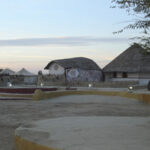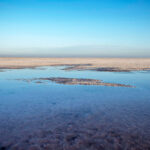GUJARAT GOLDEN TRIANGLE TOUR
Overview Gujarat Golden Triangle Tour Package Itinerary: – Ahmedabad – Patan – Modhera – Dasada – Little Rann of Kutch – Dasada – Bhuj – Hodka – Anjar village – Mumbai – Elephanta Caves
Visit some jewels of Gujarati desert. Admire the traditional mud houses (Bhungas) of Kutch in which mirrors are embedded. Dasada – a little Rann of Kutch a desert wildlife sanctuary where you can spot the very rare and almost extinct Asiatic wild asses. Step back in time as you visit the Sabarmati Ashram, founded in 1917 by Gandhi, on his return from South Africa. It was the starting point of the salt march of 1930, the first act of peaceful resistance to the English and the movement for Indian independence. Experience the major textile centre and India’s first UNESCO accredited World Heritage City – Ahmedabad. Feel the fast pace of modern Mumbai, Elephanta Island.




ARRIVAL AHMEDABAD
Arrival Ahmedabad in the morning, on arrival transfer to hotel. Post lunch visit capital of the state of Gujarat, visit the Akshardham Temple in Gandhinagar, built by the Swami Narayan sect and by more than 1000 artisans. It consists of a vast complex covered with admirable gardens and fountains. Overnight Stay at hotel.
AHMEDABAD
Morning after breakfast we visit Calico Museum and its extraordinary collection of ancient textiles, from numerous archaeological sites ranging from Egypt to India. Ahmedabad was and still is a major textile center of the country. The collection of 12th century Kalamkaris, made to order for the Dutch and the English, is remarkable.. Then visit the Sabarmati Ashram, founded in 1917 by Gandhi, on his return from South Africa. It was the starting point of the salt march of 1930, the first act of peaceful resistance to the English and the movement for Indian independence.
AHMEDABAD- PATAN- MODHERA- DASADA (LITTLE RANN OF KUTCH)
Today after breakfast we drive to Patan visit PATOLA WEAVING: Patola is a double ikat woven from silk, made in Patan, There are hardly families in Patan now that weave these highly prized double ikat sarees. RANI KI VAV (Step Well ): on the banks of the Saraswati River, was initially built as a memorial to a king in the 11th century AD.It was built at the height of craftsmen’s’ ability in step well construction and the Maru-Gurjara architectural style, reflecting mastery of this complex technique and great beauty of detail and proportions. Later we drive towards Modhera: visit MODHERA SUN TEMPLE: The Modhera Sun Temple was made by King Bhima I of the Chalukya dynasty in the early 11th century. It is a temple made to honour the Sun God in Modhera village of Mehsana district on the bank of River Pushpavati. After the visit we will drive to Dasada. On arrival check in to the hotel. Post lunch, visit local villages to interact with villagers. In the evening, we visit Bajana Lake for visualizing the mesmerizing views of the sunset. Dinner / Overnight at hotel.
DASADA
Dasada, a village that falls within Gujarat's Little Rann of Kutch. Dasada has a famed desert wildlife sanctuary where you can spot the very rare and almost extinct Asiatic wild asses. Today early morning we will visit Jeep safari wildlife across the desert sanctuary. The panoramic view makes your wildlife experiences all the more impactful. Return to the hotel and have your breakfast. Post lunch after Jeep Safari Tour.
DASADA
Today early morning we will visit Jeep safari wildlife across the desert sanctuary. The panoramic view makes your wildlife experiences all the more impactful. Return to the hotel and have your breakfast. Post lunch after Jeep Safari Tour.
DASADA – BHUJ (300 km)
Morning after breakfast, drive to Bhuj, The region is renowned for its vast plains, nomadic pastoral communities, arts such as embroidery and pottery. Bhuj is also called the Jaisalmer of Gujarat. The city is surrounded by a powerful wall whose doors were still closed at night. On arrival check in to the hotel. Later we will visit the local Bazaar. Dinner / Overnight at hotel.
BHUJ-HODKA (65 KM)
This morning after breakfast, we will depart for the village of Hodka. We visit typical villages, meet families of craftsmen and take the opportunity to admire their finely executed embroidery work (Pakko, Neran, Kambhiro, Applique styles, etc., as well as their leather work. We also explore Virda, where you learn about the ancient technique of drawing water from the Banni lands (dry lands). Lunch at Shamm e Mahfil site listed as a UNESCO World Heritage Site, in Hodka. It is a village (Mutwa community) generally built of traditional mud houses (Bhungas), in which mirrors are embedded. Sunset from the village of Dhordo.Later we will visit the Dattatray Temple located at the top of Karodungar, to admire the most beautiful views of the great Rann of Kutch. Dinner / Overnight at hotel.
BHUJ-ANJAR VILLAGE (60 KM)
Early drive to the village of Anjar, known for its metalwork and tie-dyeing. We visit the workshops of Ajrakh (woodblock printing), the Bhujodi master weavers, as well as the village of Ahir, where the Dhaneti are the specialists in mirror work. Lunch at a restaurant in Anjar before returning to Bhuj to visit the local bazaar. Dinner / Overnight at hotel.
BHUJ – MUMBAI (FLIGHT)
After Breakfast Drive to Airport catch flight to Bombay, on arrival transfer to hotel. Evening walking to GATEWAY OF INDIA: The Gateway of India is an arch monument built during the 20th century in Bombay. The monument was erected to commemorate the landing of King George V and Queen Mary at Apollo Bunder on their visit to India in 1911. Built in Indo-Sarcenic style, the foundation stone for the Gateway of India was laid on 31 March 1911. Later we will visit HOTEL TAJ MAHAL. Dinner / Overnight at hotel.
MUMBAI Visit & Departure
After Breakfast visit ELEPHANTA CAVES: The Elephanta Caves features two hillocks separated by a narrow valley. The small island is dotted with numerous ancient archaeological remains that are the sole testimonies to its rich cultural past. These archaeological remains reveal evidence of occupation from as early as the 2nd century BC. The rock-cut Elephanta Caves were constructed about the mid-5th to 6th centuries AD. After Lunch visit CHHATRAPATI SHIVAJI MAHARAJ VASTU MUSEUM: formerly named Prince of Wales Museum. Since the year 1998 though, it has been renamed to CSMVS. With an astounding number of exhibits, close to 50 thousand, the galleries of this museum are guaranteed to keep you occupied . Built in the early 20th century, the halls of this mansion have items dating back to the 2nd century A.D. Later drive to the hotel enroute Photography at Victoria Railway Station. Evening have dinner & Transfer to Airport to catch flight to your onward destination journey.
